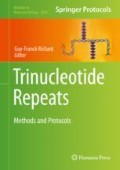Abstract
Physical separation of branched DNA from linear molecules is based on the difference of mobility of linear versus branched DNA during two-dimensional agarose gel electrophoresis. Structured DNA migrates as slower species when compared to linear DNA of similar molecular weight. Metabolic processes such as S phase replication or double strand-break repair may generate branched DNA molecules. Trinucleotide repeats are naturally prone to form secondary structures that can modify their migration through an agarose gel matrix. These structures may also interfere in vivo with replication, by slowing down replication-fork progression, transiently stalling forks, possibly leading to secondary structure such as Holliday junctions or hemicatenanes. Alternatively, reversed replication forks may occur following fork stalling, disrupting replication dynamics and modifying DNA migration on agarose gel. So although two-dimensional agarose gel electrophoresis theoretically allows to resolve a mixture of structured DNA molecules and quantify them by radioactive hybridization, its practical application to trinucleotide repeats faces some serious technical challenges.
Access this chapter
Tax calculation will be finalised at checkout
Purchases are for personal use only
References
Bell L, Byers B (1983) Separation of branched from linear DNA by two-dimensional gel electrophoresis. Anal Biochem 130:527–535
Brewer BJ, Fangman WL (1987) The localization of replication origins on ARS plasmids in S. cerevisiae. Cell 51:463–471
Schvartzman JB, Martinez-Robles ML, Lopez V, Hernandez P, Krimer DB (2012) 2D gels and their third-dimension potential. Methods 57:170–178
Schwacha A, Kleckner N (1995) Identification of double Holliday junctions as intermediates in meiotic recombination. Cell 83:783–791
Hunter N, Kleckner N (2001) The single-end invasion: an assymetric intermediate at the double-strand break to double-Holliday junction transition of meiotic recombination. Cell 106:59–70
Kim JC, Mirkin SM (2013) The balancing act of DNA repeat expansions. Curr Opin Genet Dev 23:280–288
Richard G-F, Kerrest A, Dujon B (2008) Comparative genomics and molecular dynamics of DNA repeats in eukaryotes. Microbiol Mol Biol Rev 72:686–727
Pearson CE, Edamura KN, Cleary JD (2005) Repeat instability: mechanisms of dynamic mutations. Nat Rev Genet 6:729–742
McMurray CT (2010) Mechanisms of trinucleotide repeat instability during human development. Nat Rev Genet 11:786–799
Usdin K, House NC, Freudenreich CH (2015) Repeat instability during DNA repair: insights from model systems. Crit Rev Biochem Mol Biol 50(2):142–167. https://doi.org/10.3109/10409238.2014.999192
Orr HT, Zoghbi HY (2007) Trinucleotide repeat disorders. Annu Rev Neurosci 30:575–621
McMurray CT (1999) DNA secondary structure: a common and causative factor for expansion in human disease. Proc Natl Acad Sci U S A 96:1823–1825
Samadashwily G, Raca G, Mirkin SM (1997) Trinucleotide repeats affect DNA replication in vivo. Nat Genet 17:298–304
Pelletier R, Krasilnikova MM, Samadashwily GM, Lahue R, Mirkin SM (2003) Replication and expansion of trinucleotide repeats in yeast. Mol Cell Biol 23:1349–1357
Anand RP et al (2012) Overcoming natural replication barriers: differential helicase requirements. Nucleic Acids Res 40:1091–1105
Viterbo D, Michoud G, Mosbach V, Dujon B, Richard G-F (2016) Replication stalling and heteroduplex formation within CAG/CTG trinucleotide repeats by mismatch repair. DNA Repair 42:94–106
Saini N et al (2013) Migrating bubble during break-induced replication drives conservative DNA synthesis. Nature 502:389–392
Sugawara N, Haber JE (1992) Characterization of double-strand break-induced recombination: homology requirements and single-stranded DNA formation. Mol Cell Biol 12:563–575
Kim JC, Harris ST, Dinter T, Shah KA, Mirkin SM (2017) The role of break-induced replication in large-scale expansions of (CAG)n/(CTG)n repeats. Nat Struct Mol Biol 24:55–60
Mosbach V, Poggi L, Viterbo D, Charpentier M, Richard G-F (2018) TALEN-induced double-strand break repair of CTG trinucleotide repeats. Cell Rep 22:2146–2159
Richard G-F, Goellner GM, McMurray CT, Haber JE (2000) Recombination-induced CAG trinucleotide repeat expansions in yeast involve the MRE11/RAD50/XRS2 complex. EMBO J 19:2381–2390
Mosbach V, Poggi L, Richard G-F (2018) Trinucleotide repeat instability during double-strand break repair: from mechanisms to gene therapy. Curr Genet 65(1):17–28. https://doi.org/10.1007/s00294-018-0865-1
Gomes-Pereira M, Monckton DG (2017) Ethidium bromide modifies the agarose electrophoretic mobility of CAG•CTG alternative DNA structures generated by PCR. Front Cell Neurosci 11:153
Fierro-Fernandez M, Hernandez P, Krimer DB, Schvartzman JB (2007) Replication fork reversal occurs spontaneously after digestion but is constrained in supercoiled domains. J Biol Chem 282:18190–18196
Fierro-Fernandez M, Hernandez P, Krimer DB, Schvartzman JB (2007) Topological locking restrains replication fork reversal. Proc Natl Acad Sci USA 104:1500–1505
Marbouty M, Ermont C, Dujon B, Richard G-F, Koszul R (2014) Purification of G1 daughter cells from different Saccharomycetes species through an optimized centrifugal elutriation procedure. Yeast 31:159–166
Holmes A et al (2012) Lsd1 and lsd2 control programmed replication fork pauses and imprinting in fission yeast. Cell Rep 2:1513–1520
Lopes M, Cotta-Ramusino C, Liberi G, Foiani M (2003) Branch migrating sister chromatid junctions form at replication origins through Rad51/Rad52-independent mechanisms. Mol Cell 12:1499–1510
Liberi G et al (2006) Methods to study replication fork collapse in budding yeast. Methods Enzym 409:442–462
Brachmann CB et al (1998) Designer deletion strains derived from Saccharomyces cerevisiae S288C: a useful set of strains and plasmids for PCR-mediated gene disruption and other applications. Yeast 14:115–132
Acknowledgments
Work on 2D gels in our lab was generously supported by the Centre National de la Recherche Scientifique (CNRS) and by the Institut Pasteur.
Author information
Authors and Affiliations
Corresponding author
Editor information
Editors and Affiliations
Rights and permissions
Copyright information
© 2020 Springer Science+Business Media, LLC, part of Springer Nature
About this protocol
Cite this protocol
Viterbo, D., Richard, GF. (2020). Quantifying Replication Fork Progression at CTG Repeats by 2D Gel Electrophoresis. In: Richard, GF. (eds) Trinucleotide Repeats. Methods in Molecular Biology, vol 2056. Humana, New York, NY. https://doi.org/10.1007/978-1-4939-9784-8_4
Download citation
DOI: https://doi.org/10.1007/978-1-4939-9784-8_4
Published:
Publisher Name: Humana, New York, NY
Print ISBN: 978-1-4939-9783-1
Online ISBN: 978-1-4939-9784-8
eBook Packages: Springer Protocols

